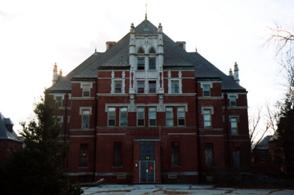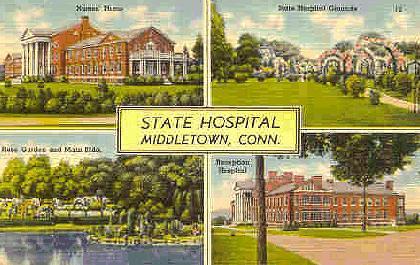Connecticut
Number of victims
557
people were sterilized up to 1963, of whom 92%
were female. 74%
were considered mentally
ill and 26% were deemed “mentally deficient.”
Period during which sterilizations occurred
Sterilizations
in Connecticut began after the passage of the state’s sterilization law
in 1909 and continued up to around 1963. The two major periods of
increased sterilization were between 1920 and 1929 and 1930 and 1940
(including the peak period 1930-1932), during which 173/218 operations
were performed.
Temporal pattern of sterilizations and rate of sterilization

Although
Connecticut’s sterilization law was passed in 1909, sterilization was
not implemented on a larger scale until the early 1920s. In the 1920s,
the 1930s, and the early 1940s, there were on average about 20
sterilizations per year. Although sterilizations continued to occur
after 1943, the numbers were not as high (Paul, p. 304). During the
peak period 1930-1932, the rate of sterilizations per year per 100,000
residents was about 3.
Passage of law(s)
Connecticut
was the second state to adopt eugenic laws using Indiana Plan as a
model (Reilly, p. 34). First introduced in February of 1909 by
Representative Wilbur F. Tomlinson, the Connecticut sterilization
statute was passed on August 12, 1909 (listed in the 1918 General
Statues of Connecticut and cited as Title 22, Chapter 137, Sections
2691 and 2692 (Landman, p. 60)) (Laughlin, p. 19), and concerned
“operations for the prevention of procreation” (Laughlin, p. 19).
It was one of the shortest sterilization laws in the country (Paul, p.
295). Connecticut's sterilization policy was also one of the nation's
oldest (Paul, p. 294) and most curious in that it was simultaneously
highly conservative and vague, ambiguous, and lacking in procedural
safeguards. The law allowed for the sterilization of certain patients
in the state hospitals for the insane at Middletown and Norwich. The
law also gave the staff at the two hospitals permission to examine the
patient’s family tree to help decide if the patient should be
sterilized (Black, p.67-68). The law permitted either male or female
sterilizations through vasectomies or ovariectomies respectively
(Black, p. 67-68). Once the law was established, medical officials
became interested in ways to sterilize massive groups of people
(Reilly, p. 100). The locations for operations extended to the
Mansfield State Training School and Hospital at Mansfield Depot in a
1919 amendment (Laughlin, p. 20). On July 1, 1965, the governor
signed a bill that replaced the word oophorectomy with tubal surgery
and required consent of an individual prior to the operation.
Under this new law, a “competent” person who gives consent of her own
surgery must also have the written consent of “‘the responsible next of
kin or guardian of such persons or, if there is none, with the approval
of the board of trustees of the institution’” (Paul, p. 299).
In the 1965 Griswold vs. Connecticut lawsuit, the Supreme Court
overturned the Connecticut law prohibiting contraceptive use, paving
the way for a nation-wide transition in the interpretation of
sterilization laws as inclusive of voluntary rights rather than as
exclusively compulsory (Robitscher, p. 63). In the past, Connecticut
had laws explicitly forbidding doctors from performing voluntary
sterilizations on patients (Robitscher, p. 64). The verdict of Griswold
stated that “intimacies of the marriage bed were beyond control of the
law” (Robitscher, p. 63). This meant that individuals had a right to
privacy and freedom from state authority when it came to reproductive
control. Justice Goldberg of the case decreed that in order to force
couples to be sterilized against their will, the evidence supporting
sterilization had to be compelling, and of subordinating interest
(Robitscher, p .73). This brought an end to intra-marriage
sterilization without sound reasoning.
In the past, Connecticut had laws limiting sterilization solely for the
purposes of medical necessity, but in 1965 and 1969, new legislation
that removed all previous restrictions was passed. This effectively
changed Connecticut's sterilization laws from being compulsory to being
voluntary (Robitscher, p. 25-26). This law went into effect in October
1971 (Gonzales, p. 2581).
In 1982, the state amended its 1979 sterilization statute to
specify necessary factors needed to make appropriate judicial decisions
in regard to sterilizing individuals. The statue asks of the court to
take "sexual maturity, understanding of reproduction and contraception,
capability to perform sexual activity, ability to care for a child, and
nonpermanent contraceptive methods" into account when considering
sterilization (Bush, p.113). Furthermore, in 1979, hysterectomies
became prohibited for contraceptive and permanent birth control
purposes (Bush, p.114).
Groups identified in the law
In
the United States, sterilization laws generally targeted those whose
monitored procreation would allow for the preservation of morality,
improvement in financial and social sectors, and general betterment of
society (Largent, p. 32).
The original law included “inmates of State prisons and State Hospitals
at Middletown and Norwich” and who “would produce children with and
inherited tendency to crime, insanity, feeble-mindedness, idiocy, or
imbecility” (Laughlin, p. 8, 20). These groups were considered to be
"in a class by themselves" (Paul, p. 305), as explicitly stated by one
Attorney General John H. Light in 1912, and as such necessitated the
state's "different relationship to them than to any other
classification of a part of [the] people" (Paul, p. 305).
Process of the law
Three
surgeons would examine the mental and physical capabilities of the
individuals at hand, consider the person’s chances of improvement,
examine his or her family history, and weigh the chances of negative
procreation. The board would then come to a decision about
whether or not sterilization was necessary. Females who were
ordered to be sterilized underwent oophorectomy (removal of the
ovaries) while males were sent to have vasectomies (Laughlin, p. 8;
Paul, p. 298).
Connecticut was the only state requiring the more intrusive
oophorectomy operation for females; a 1965 amendment to the state
sterilization law lists "tubal surgery" or salpingectomy as the
accepted procedure (Paul, p. 307). The process of the law as detailed
above is described very similarly by Deputy Commissioner of Health Bert
W. Schmickel years later in 1965, in regards to the procedure for
approving sterilization operations at Southbury Training School (Paul,
p. 306). In addition to being reviewed by the Children's Committee,
Medical Committee, Social Service committee of the institution, and two
unaffiliated physicians, a request for the sterilization of a patient
required a supporting written statement of consent from the legal
parents or guardians of the individual it concerned (Paul, p. 306).
Precipitating factors and processes
In
Connecticut in the early 19th century, “enlightenment humanism,
republic civic concern, and religious enthusiasm” spread the idea that
asylums were an effective way to improve the behavior of mentally and
physically challenged individuals. This idea led to the creation of the
American School for the Deaf in 1817 and the Retreat for the Insane in
1824 in Hartford, and the Hospital for the Insane at Middletown in 1868
(known today as the Middletown State Hospital). Mass
institutionalization was a phenomenon that predated the American
eugenics movement and precipitated the transition from segregation to
sterilization policies. In 1868, in response to overcrowding at the
private Hartford Retreat for the Insane, the state of Connecticut
established the larger Middletown Hospital for the Insane. Developing
social conceptions of racial, moral, and eugenical purity in the late
nineteenth and early twentieth centuries broadened the criteria for
which patients were referred to the state's first public institution,
including "insane immigrants, long-lived lunatics, crazed alcoholics,
the senile, and almshouse denizens" (Goodheart, 2010, p. 127) among the
"insane". Due to a substantially increasing patient population (over
2000 patients had been committed by 1900 (Goodheart, 2010, p. 109),
this institution, among others in Connecticut and other states,
experienced a transition from patient care ideals of nurture and
improvement to "custodianship" of the masses. On a related note and as
a consequence of this transition, however, patients in these facilities
did not produce the expected results after taking part in various
levels of education, and connections between diseases in different
generations in families were made (Goodheart, 2004, p. 93, 96). In the
late 1800s, concerns about the dangers of the “feeble-minded” class
were voiced in the context of mass immigration, urbanization, and labor
unrest, combined with an economic depression in 1893 (Goodheart, 2004,
p. 105). Numerous laws were passed at this time to separate the pure
native stock from the "tainted immigrant", and included the quarantine
of ships and regulation of vaccinations (Caron, p. 36).
Groups targeted and victimized
Sterilization policies and related laws primarily targeted paupers, criminals, imbeciles, and idiots. (Goodheart, 2004, p. 107).
Other restrictions places on those identified in the law or with disabilities in general
An
Act Concerning Crimes and Punishments was passed
in 1895. It banned the marriage of “epileptics, imbeciles, and the
feebleminded”
(Goodheart, 2004, p. 106). Additionally, men who had sexual intercourse with
these
same victimized groups of women would be fined $1,000 and sent to
prison
(Goodheart, 2004, p. 107).
Marriage Restrictions
Other western states also started to establish laws to prohibit
whites from marrying Asians, and then epileptics, imbeciles and
feebleminded people as well (Caron, p. 53). This fear of “degeneracy”
led to the passing of the eugenic marriage restriction law in 1895 and
preceded the passing of the eugenic sterilization law. Connecticut was the first state to prohibit marriage of “defective”
people (Reilly, p. 26). Though the state did not have a statute
expressing the prohibition of marriage of those who were “mentally
deficient”, it was inferred that such marriages were void (Schuler,
p. 304). The state did, however, have a law that restricted a person who
was under guardianship due to perceived "incompetence" from being able
to enter into marriage (Schuler, p. 305). Connecticut prohibited
issuing a marriage license if either person is under guardian
control/supervision without written consent from the guardian (Schuler,
p. 309). However, a woman past 45 years old and the age of child
bearing, would be able to get married (even if she had been previously
or was presently committed to an institution. Those considered to be
insane and who had been under guardianship were also included in the
ban against marriage (Schuler, p. 313), except in cases where written
consent from a guardian was obtained.
Violations of marriage restriction laws could be punished with a maximum sentence of three years in prison (Schuler, p.
310). Also, individuals accused of assisting “defectives”, whether
"feeble-minded" or insane, with getting married would be fined $1000 or
sentenced to five years in prison (and possibly both) (Schuler, pp. 311,
316). Furthermore, any individual who engaged in intercourse with female of
"defective" nature under 45 was subject to three years in prison
(Reilly, p. 26). This particular age was pivotal because at 45 years
the likelihood of pregnancy was dramatically reduced and these
individuals presented minimal risk for the propagation of “defective”
offspring (Lombardo, p. 45). While high-ranking officials such as James
C. Carter (president of the American Bar Association at the turn of the
century) and William T. Belfield (a Chicago medical doctor) praised
Connecticut for its marriage restrictions (Largent, pp. 32, 64), which
would curtail the perceived threat of "racial degeneration",
enforcement of these laws was for the most part weak and irregular
(Reilly, p. 27). A shift in legislative activity was observed in 1910
as marriage restriction policies fuelled more extreme eugenical legal
tools that incorporated compulsory sterilization policies (Reilly, p.
65).
Abortion and Birth Control
Connecticut marriage laws ultimately did not seek to prevent
"defective" individuals from marrying, but rather to control
reproductive activity that would potentially lead to unhealthy and
undesirable children (Largent, p. 65). As
far back as the mid-1800's, Connecticut struggled with issues of
adapting birth control and other contraceptives. In Connecticut,
abortion was a crime only if it happened post quickening (Caron, p.
24). By the end of WWII, Connecticut and Massachusetts were the only
two states where doctors were not allowed to prescribe contraceptives
as an alternative to sterilization for birth control measures (Caron,
p. 117). Catholic groups prevented limited birth control options and
prevented the establishment of clinics where people could undergo
sterilization as a form of permanent birth control, resulting in
abortion tourism in Rhode Island where such procedures were legal
(Caron, p. 145).
Major proponents
Dr.
George H. Knight undoubtedly shaped the eugenics movement in
Connecticut. He was a proponent of colonies for the “feebleminded” and
encouraged confining and segregating “the custodial class” (Goodheart,
2004, p. 102-104). He played a role in an epileptic asylum and
worked to pass An Act Concerning Crimes and Punishments, which, among
other restrictions, prohibited disabled people from marrying
(Goodheart, 2004, p. 106). He preached eugenics to various audiences
and expressed how education in asylums, as presented by his father, Dr.
Henry M. Knight, founder of the private Connecticut School for
Imbeciles in 1858, was not an effective solution to the problems of the
disabled (Goodheart, 2004, p. 107). He supported the passing of
Connecticut’s sterilization law in 1909 (Goodheart, 2004, p. 109).
In addition to Knight, eugenicist Harry H. Laughlin played a
substantial role in the advancement of Connecticut eugenic ideologies
and sterilization policies and frequency. Under commission by governor
Wilbur Cross, Laughlin conducted a 1936 "Survey of the Human Resources
of Connecticut", collecting data from 160 towns in eight counties
across the state and drafting a plan to sterilize approximately 175,000
Connecticut residents according to 21 "cross-classifications" including
"Race Descent" and "Nativity and Citizenship" (Black, 2003). The first
sterilizations were to be performed on 11,960 "weak, disabled, morally
unacceptable or otherwise 'socially inadequate'" individuals residing
in state prisons (Black, 2003).
Edwin
A. Down, president of the Connecticut State Board of Charities,
presented the idea of sterilization as an act of charity during the
first annual State conference of Charities and Corrections (Largent, p.
37). He claimed that it would be beneficial to the greater community to
sterilize "degenerates", and the potential harm that could come to the
inadequate individual through the process of sterilization was minimal
in comparison to the damage a "degenerate" person could inflict on
society (Largent, p. 37).
Connecticut native Charles Davenport was a noted biologist who studied
heredity in the 1890s. He became very interested in the American
eugenics movement and was involved with the American Breeders
Association Committee on Eugenics (Lombardo, p. 42). Davenport urged
for people to contribute family pedigrees to establish genetic
databases and aid in the understanding of genetic transmittance of
familial traits and diseases. Perhaps his most significant contribution
the eugenics campaign was his founding of the Eugenics Record Office
(ERO) in Cold Spring Harbor, New York in 1910 (Lombardo, p. 30).
Through the activity of this "scientific" organization, Davenport
became a mentor to his successor as superintendent, Harry Laughlin.
Following Davenport's retirement in the mid-1930s, the ERO experienced
an onslaught of attacks on its methods and scientific legitimacy, its
collected records of heredity described as being a "vast and inert
accumulation...unsatisfactory for the scientific study of human
genetics" (Lombardo, p. 205).
“Feeder
institutions” and institutions where sterilization were performed
In
1855, following Massachusetts, the Connecticut legislature set in
motion the development of institutions to provide care for the
"mentally deficient" (Reilly, p. 12).
 (Photo
origin: abandonedbutnotforgotten.com; available at
http://www.abandonedbutnotforgotten.com/norwich_state_hospital_sub_pics.htm)
(Photo
origin: abandonedbutnotforgotten.com; available at
http://www.abandonedbutnotforgotten.com/norwich_state_hospital_sub_pics.htm)
The
Norwich State Hospital housed the mentally ill beginning in 1904 and
had 3,180 patients by the 1950s. All eugenical sterilizations in
Connecticut occurring before the end of 1920 took place at this
institution; most sterilizations also took place here up to1925. The
facility closed in 1996 and is abandoned (Opacity).
 (Photo origin: rootsweb.com; available at http://www.rootsweb.ancestry.com/~asylums/connecticut_ct/index.html)
(Photo origin: rootsweb.com; available at http://www.rootsweb.ancestry.com/~asylums/connecticut_ct/index.html)
Sterilization
operations also occurred at the General Hospital for Insane. In 1866,
legislation called for the establishment of a hospital for the insane
that resulted in the 1867 opening of the General Hospital for Insane in
Middletown. Over the years, the institution has undergone a series of
name changes, becoming the Connecticut Hospital for the Insane in 1874
and the Connecticut State Hospital by 1879, finally assuming its
current title, the Connecticut Valley Hospital, in 1961 (Connecticut
State Library). In 1995 and 1996, this institution accepted patients
from both Fairfield Hills Hospital and Norwich Hospital upon both
hospitals' closures (Connecticut State Library). Currently, it contains
a psychiatric region, a forensic area, and a substance abuse assistance
division (Rootsweb).
 (Photo origin: http://2007newenglandtrip.blogspot.com/2008/03/southbury-connecticut.html)
(Photo origin: http://2007newenglandtrip.blogspot.com/2008/03/southbury-connecticut.html)
Almost
all sterilizations after World War II took
place in the Southbury Training School (Paul, p. 306 n. 5), which was
an
institution for mentally challenged individuals.
A total of at least 60 people were sterilized
in this facility after World War II (Paul, p. 303), which presently is
a
facility that has 696 residents and is located in Southbury, CT
(Kasprak).
Julius Paul notes that, in fact, “many requests for sterilizations
[were]
refused because the children do not fall into the category of familial
mental
retardation” (p. 296).
The Mansfield State Training School and Hospital was also a place where sterilizations were performed, but the number of sterilizations was apparently very small, due to the fact that a former superintendent only once consented to such an operation on a resident (see Paul, p. 310 n. 17). The facility closed in 1993 (Connecticut State Library).
It is also worth mentioning the Undercliff Sanatorium of Meriden, originally known as the Meriden Sanatorium. Established in 1910 to provide institutional care for children suffering from tuberculosis, the Undercliff State Hospital was active until 1976 and over the decades housed individuals that by eugenical standards would have been deemed "defective" (i.e. the chronically ill, tubercular, mentally ill, etc.) (Connecticut State Library). While there appear to be no official records or documentation that suggest the use of eugenical sterilization, many institutions are reluctant to disclose any such history for fear of negative public response. Thus, and especially so because many of the patients housed at Undercliff fit the criteria used by other institutions for selective sterilization, it remains that this hospital may have in fact participated in the eugenics movement in some way. However, further research is needed to justify these claims.
The
sources used for this research did not include
any information about the facilities’ eugenic pasts or use of
sterilization
methods.
Opposition
The Connecticut sterilization laws were not as drastic as those drawn up in other states, partly due to the high levels of opposition that the proponents faced. They dealt with religious group opposition that is reported for the early period (Paul, p. 310 n. 14), the concern over court reviews of a sterilization law that provided procedural safeguards and appeal process, and early on also the reluctance of some leaders of institutions to participate (see Paul, p. 301).
A
bill to repeal Connecticut's 1909 sterilization statute was at one
point introduced by state Representative Katharine A. Evarts of Kent in
collaboration with Dr. Wilfred Bloomberg, Commissioner of Mental Health
(of the Department of Mental Health), however the bill was opposed by
the Department of Health (represented by Commissioner Dr. Franklin
Foote), which held equal jurisdiction over sterilization policies
(Paul, p. 298).
Julius Paul's 1965 article on state eugenic sterilization laws reported that despite initial opposition, the law remained relatively unchallenged after 56 years in effect (p. 301). Paul himself describes the state's sterilization policies of 1965 as being "careful [and] selective", although still vague and highly subjective, with little modifications having been made to the original policies of decades earlier to address the loopholes and lack of procedural safeguards (p. 302).
By
the 1920s, the Catholic Church had established itself as the most
prominent opponent of eugenical sterilization proposals and
Connecticut's birth control bills (Reilly, p. 118). Abortions were only
permitted for life-endangering situations and clinics were prohibited
from operating in the state (Caron, pp. 124, 142, 239). Predominating
religious beliefs were such that "inferior beings" (that is, those who
were "feebleminded" or imbecilic, for example) would eventually yield
to more "superior" beings, but that human intervention through
sterilization procedures was an unnatural way to achieve this result
(Rosen, p. 49).
Bibliography
Bush, D. 1983. "Fertility-Related State Laws Enacted in 1982." Family Planning Perspectives 15(3): 111-116.
Caron, Simone M. 2008. Who Chooses? American Reproductive History since 1830. Gainesville: University Press of Florida Press.
Connecticut State Library. “Connecticut Valley Hospital.” Available at <http://www.cslib.org/agencies/connecticutvalleyhospital.htm>
Connecticut State Library. “The Mansfield Training School and Hospital.” Available at <http://www.cslib.org/agencies/MansfieldstatetrainingSchool.htm>
Connecticut State Library. “Undercliff.” Available at <http://www.cslib.org/agencies/undercliff.htm>
Goodheart, Lawrence B. 2004. “Rethinking Mental Retardation: Education and Eugenics in Connecticut, 1818-1917.” Journal of the History of Medicine and Allied Sciences 59: 90-111.
Goodheart, Lawrence B. 2010. “From Cure to Custodianship of the Insane Poor in Nineteenth-Century Connecticut.” Journal of the History of Medicine and Allied Sciences 65, 1: 106-130.
Kasprak, John. 2000. “Southbury Training School.” OLR Research Report. Available at <http://www.cga.ct.gov/2000/rpt/olr/htm/2000-r-0103.htm>.
Landman, J. H. 1932. Human Sterilization: The History of the Sexual Sterilization Movement. New York: MacMillan.
Largent, Mark A. 2008. Breeding Contempt. New Brunswick: Rutgers University Press.
Laughlin, Harry H. 1922. Eugenical Sterilization in the United States. Chicago: Psychopathic Laboratory of the Municipal Court of Chicago.
Lombardo, Paul. 2008. Three Generations, No Imbeciles. Baltimore: Johns Hopkins University Press.
Opacity: Urban Ruins. “Norwich State Hospital.” Available at <http://www.opacity.us/site64_norwich_state_hospital.htm>.
Paul, Julius. 1965. “‘Three Generations of Imbeciles Are Enough’: State Eugenic Sterilization Laws in American Thought and Practice.” Washington, D.S.: Walter Reed Army Institute of Research. Available at <http://buckvbell.com/pdf/JPaulmss.pdf>.
Reilly, Philip R. 1991. The Surgical Solution. Johns Hopkins University Press.
Robitscher, Jonas. 1973. Eugenic Sterilization. Springfield: Charles C Thomas Publisher.
Rootsweb. “Connecticut State Hospital.” Available at <http://www.rootsweb.ancestry.com/~asylums/connecticut_ct/index.html>.
Rosen, Christine. 2004. Preaching Eugenics. Oxford: Oxford University Press.
Schuler, Ruth V. 1940. “Some Aspects of Eugenic Marriage Legislation in the United States.” The Social Service Review 14 (2): 301-316.